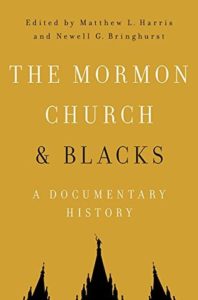 Title: The Mormon Church and Blacks: A Documentary History
Title: The Mormon Church and Blacks: A Documentary History
Editors: Matthew L. Harris and Newell G. Brinhghurst
University of Illinois Press, 2015
Reviewed by Peter Wilson, June 2020.
Reading Matthew Harris and Newell Brinhghurst’s book The Mormon Church and Blacks: A Documentary History helped me recognize not only the troubling history of blacks in The Church of Jesus Christ of Latter-day Saints, but also ways in which that history persists. Unfortunately, this important book is marred by some misleading representations that lead me to recommend reading this book with caution.
I appreciated the high ratio of primary source text to commentary. The primary sources include scriptures, statements made by church leaders beginning with Joseph Smith, and the Church-approved Gospel Topics Essay “Race and the Priesthood,” published in 2013. Many of the primary sources I had never seen before, such as the letter from David Gillispie, a black member of the Church living in Ogden, Utah, to David O. Mckay, the President of the Church in 1967. This letter, which recounts Brother Gillispie’s struggles as a black member, was the most heart-wrenching part of the book for me. He starts his letter, “Dear Beloved, President McKay,” and his love for the church is obvious. But he also reveals that he feels “bitterness the likes of which I have never felt before” developing within him in regard to the priesthood ban and the way it has profoundly affected his life (Chapter 5).
While I appreciated access to these primary sources, I also am bothered by the idea that the authors may have misrepresented some of these sources, as they certainly did in the case of the Book of Mormon. Particularly because there is little editorializing in this book, the authors’ introductory comments to primary source material are significant. The second of four paragraphs of introductory material to the Book of Mormon begins as follows:
The Book of Mormon, while not directly addressing race involving blacks or people of African descent, alluded to them through its use of the term black interchangeably with red in describing various dark-skinned people and the curse inflicted on them.
The above sentence is false and misleading in a variety of different ways:
• The word “red” is never used in the Book of Mormon to describe a “dark-skinned people.” The authors reference Alma 3:13 in their footnote, but this scripture does not refer to skin color at all; it states that the Amlicites had marked themselves with “a mark of red upon their foreheads” (Alma 3:13).
• The word “interchangeably” suggests that the terms “black” and “red” appear often in the Book of Mormon. However, “blackness” comes up only once to describe skin (see 2 Nephi 5:21) and “red” only occurs twice, a few verses apart, in reference to the color of a mark on the forehead (see Alma 3:4, 13).
• The word “interchangeably” also suggests that the terms “black” and “red” describe the same groups of people. However, “blackness” is used in reference to the early Lamanites, and the “red” mark is self-assigned by the Amlicites, who are an off shoot of Nephites.
• The authors make a passing conclusion on a debated topic when they suggest that color describes the Lamanite curse. Among many others, Brent Gardner (see here and here) argues that the curse is separate from skin color.
Later in the paragraph, the authors suggest that the Jaredites may be black and then mention that the Jaredites “perished because of their unrighteousness.” In so doing, they insinuate a connection between the Jaredites’ race and their righteousness. Firstly, their argument that the Jaredites may be black is quite attenuated. Secondly, if it is true that the Jaredites have African ancestry as the authors suggest, then it is misleading to state their eventual fate without mentioning periods of prolonged righteousness, their renowned writing tradition or their prosperous civilization (see Mosiah 28:17-19, Ether 12:24, and Ether 9:16). If the Jaredites were righteous and unrighteous at different times, then clearly there was no connection between their race and their righteousness.
The authors made several significant mistakes and misleading comments in introducing the Book of Mormon to their readers. I only caught these misrepresentations because I know a fair amount about the primary source in question. Seeing this primary source misrepresented does cause me to wonder if there are other misrepresentations in the book that I missed.
Regardless, I found the book quite enlightening. It brought to my attention the history of how ideas in scripture were used to justify racist policy within the Church. While the Church has repudiated some of its racist teachings from the past, it still faces the problem of having canonized scripture with racist connotations and/or ideas (e.g. Moses 7:22, and the Joseph Smith Translation of Genesis 9:26). This presents a vexing issue, as the concept of scripture means that we do not have the luxury of updating it to fit with modern sensibilities. Part of our problem can be resolved through certain generous scriptural interpretations. Nevertheless, we have a persistent problem and I am not sure that there is an easy solution.
After reading this book, I read an article written by Kwaku El (see here) that answers the question “How could any self-respecting African American subscribe to the doctrine of the restored gospel, as given by The Church of Jesus Christ of Latter-day Saints?” While this documentary history showed the uckiness of having canonized scriptures with racist ideas, Kwaku argues that the Book of Mormon is unique among scripture because it preaches against racism. I recommend Kwaku’s thoughts to consider alongside this book for those interested in the subject.
